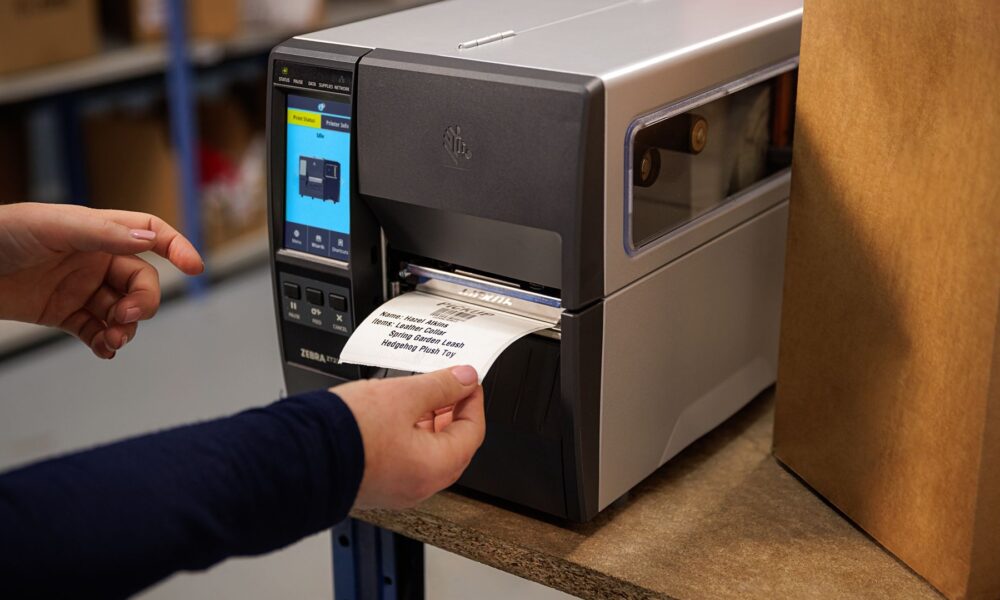In the bustling world of commerce, whether you’re dispatching hundreds of shipments daily or labelling products for retail shelves, the efficiency and clarity of your labels can significantly impact your operational flow and brand image.
Selecting the best label printer suppliers in Australia for your business isn’t just about hardware; it’s about finding a solution that aligns with your business needs, volume, and the types of labels you produce.
This comprehensive guide explores the key types of label printers – thermal, laser, and inkjet – delving into their pros and cons and providing insights to help you make an informed decision.
Understanding Label Printer Types
Here are the 3 types of label printers that you can use to keep marching ahead with growing printing needs and quality.
1. Thermal Label Printers
Thermal label printers are categorised into two types: direct thermal and thermal transfer. Both are prized for their speed, efficiency, and reliability in producing high-quality labels.
Direct Thermal Printers work by applying heat directly onto heat-sensitive paper. They’re cost-effective, easy to use, and require minimal maintenance since they don’t use ink, toner, or ribbons. These are mainly used as a shipping label printer but are more often used for product labelling as well.
However, the labels are susceptible to fading over time or when exposed to heat and sunlight, making them less ideal for long-term product labelling.
Pros:
- High print speed reduces longer wait times during printing.
- High-quality and clear images and text printing
- Simpler to operate with fewer moving parts and no need for ribbon changes.
- Eco-friendly printing
Cons:
It can fade over time when exposed to heat, light and friction.
Thermal Transfer Printer is the best label printer in Australia that uses a thermal print head to transfer ink from a ribbon onto the label material. This method produces more durable and long-lasting labels, resistant to heat, sunlight, and chemicals. They’re suitable for a wide range of applications, including inventory, asset tagging, and outdoor use. The need for ribbons increases their operational costs compared to direct thermal printers.
Pros:
- Resistant to fading, scratching, and smudging.
- It can print on paper, polyester, polypropylene and other materials, making it ideal for use for shipping labels, asset tags, and outdoor signage.
- Sharp and clear images and text which is suitable for barcode and detailed label designs.
- Availability of a variety of colour ribbon options.
Cons:
- Higher initial cost and ongoing maintenance cost of buying additional materials.
- Changing ribbons and adjusting the label material can become complex after some time.
- It can be less ideal for people conscious of environmental considerations.
Best for:
Also known as a shipping label printer, this is best for businesses that require fast, efficient label printing, such as shipping, warehousing, and retail.
2. Laser Label Printers
Laser printers are common in office environments for printing documents but can also be used for label printing. They use toner and heat to produce high-quality, durable labels. Laser label printers are capable of printing on a variety of materials and offer vibrant colour options, making them suitable for branding and high-detail labels.
Pros:
High-quality print, durability, and versatility in label materials and designs.
Cons:
Higher initial cost, operational costs due to toner replacements, and typically larger than thermal printers.
Best for:
Businesses need high-quality, durable labels with detailed graphics or branding, suitable for product packaging and corporate labelling.
3. Inkjet Label Printers
Inkjet printers are versatile and capable of printing high-quality, colourful labels. This is one shipping label printer that works by spraying tiny droplets of ink onto the label material, allowing for a wide range of colours and gradients. This type of printer is ideal for custom labels with complex designs or photographic-quality images.
Pros:
Excellent print quality with vibrant colours, suitable for custom labels with detailed images or branding.
Cons:
Higher operational costs due to ink replacements, slower print speeds compared to thermal printers, and labels may be less durable unless using specialised ink and materials.
Best for:
Small businesses and startups that require high-quality, custom labels in smaller volumes, such as boutique products, speciality foods, and custom merchandise.
Choosing the Right Label Printer for Your Business
● Assess Your Business Needs:
Consider the volume of labels you need to print, the durability required, and whether you need colour labels. High-volume shippers prefer thermal printers for their speed and efficiency. At the same time, boutique brands may opt for inkjet printers for their colour capabilities.
● Consider the Total Cost of Ownership:
Beyond the initial purchase price, consider the ongoing operational costs. Thermal printers might have a higher initial cost but lower long-term expenses due to the lack of ink or toner. Conversely, inkjet and laser printers may have higher ongoing costs for ink or toner replacements.
● Evaluate Print Quality Requirements:
If your labels need to withstand harsh conditions or long-term use, thermal transfer or laser printers offer durability. For high-detail, colourful labels, inkjet printers provide superior print quality.
● Integration with Your Existing Systems:
Ensure the label printer you choose is compatible with your current software and systems. Some printers offer better integration with certain e-commerce platforms, inventory management systems, or design software.
● Consider Label Size and Material:
Different printers accommodate different label sizes and materials. Ensure the printer you select can handle the label dimensions and materials you use, from paper to synthetic and beyond.
Final Words
Choosing the right but best label printer in Australia can streamline your operations, enhance your product presentation, and support your brand’s growth. By understanding the differences between thermal, laser, and inkjet label printers and considering your specific business needs, you can make an informed decision that aligns with your operational requirements and budget.
Whether you prioritise speed and efficiency, durability, or print quality, Dial A Label has a label printer that is a perfect fit for your business.
